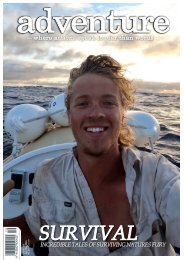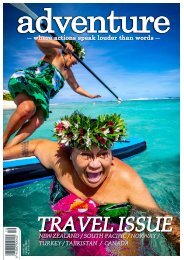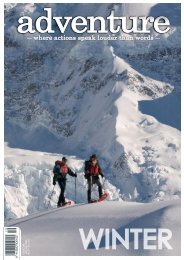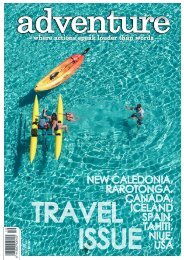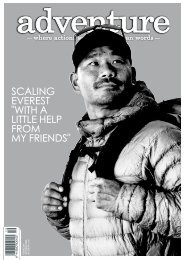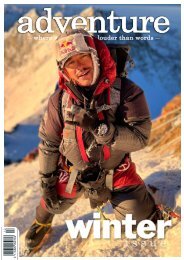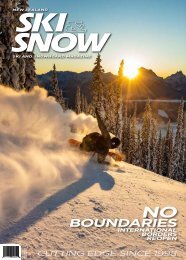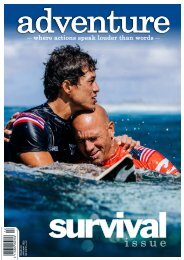Adventure Magazine April 2020
Issue #219 Survival Issue April is always our survival issue - seems fitting this year. How to survive an eruption, survive Everest, survive a Great White encounter and more.
Issue #219 Survival Issue
April is always our survival issue - seems fitting this year.
How to survive an eruption, survive Everest, survive a Great White encounter and more.
Create successful ePaper yourself
Turn your PDF publications into a flip-book with our unique Google optimized e-Paper software.
The Tongariro Alpine Crossing has by far<br />
the most incidents, however it also caters for<br />
the highest number of visitors. 150,000 walk the<br />
Tongariro Crossing each year compared to 15,000<br />
on the Milford Track.<br />
In 2018 the NZ Mountain Safety Council<br />
(MSC) produced a report called “A Walk in the<br />
Park? A deep dive into tramping incidents in New<br />
Zealand. It makes for some interesting reading<br />
on the statistics surrounding our most popular<br />
outdoor activity.<br />
In the ten years between 2007 and 2017, 57<br />
people lost their lives in tramping accidents; 31<br />
from falling, 21 from drowning, 6 from hypothermia<br />
and the remainder from avalanches and other<br />
such incidents.<br />
The role of the MSC is in preventing safetyrelated<br />
issues in land-based outdoor recreation.<br />
Fatalities due to natural cause or suicide were not<br />
analysed as they are not deemed to be safetyrelated<br />
issues. E.g. Gerd Wilde (case above)<br />
could have had his heart attack at any other point<br />
of his journey in NZ such as in a spa in Rotorua or<br />
walking along Queen Street.<br />
Of the 57 deaths, 32 were Kiwis and 25 were<br />
international visitors.<br />
The MSC noted that the most prominent<br />
causal factor of a fatality while tramping was<br />
competence, or lack of, attributing to 66% of the<br />
deaths occurring over the decade. Competence<br />
includes relevant experience, level of skill etc.<br />
The second most prominent causal factor<br />
was social and psychological factors; the state<br />
of mind of the tramper, which attributed to 62%<br />
of the fatalities; the desire to get to a destination,<br />
taking a 'short cut', or underestimation of risk were<br />
causes that factored highly.<br />
By comparison, weather and equipment<br />
were seen as the cause of only 32% and 28% of<br />
tramping deaths respectively.<br />
The other interesting information was where<br />
fatalities occurred as a result of ignoring advice,<br />
88% were male. Not surprisingly, where fatalities<br />
occurred as a result of ignoring signs, 100% were<br />
international visitors.<br />
Many people have a strange way of weighing up risk against benefits<br />
and can convince themselves that everything will be alright, despite many<br />
obvious signs that it won’t be. This is also known as “confirmation bias” or<br />
underestimating the risk. MSC insights have discovered that this was a factor<br />
in at least 17% of tramping fatalities between 2007 and 2017. The fact that<br />
so many other people have “done the crossing” and do so every year gives<br />
people a false sense of the safety of the experience. Our tourism machine<br />
has done a great job of making people really want to have an experience,<br />
despite the risks involved.<br />
So what can we do with all this information?<br />
Hopefully the research can help us to make better<br />
decisions, be aware of where the risks lie and help<br />
us become better informed. It has also highlighted<br />
some specific solutions for the Tongariro Alpine<br />
Crossing ranging from more targeted advertising<br />
of alternative tracks in the area, improvements in<br />
parts of the track itself, through to the employment<br />
of full time rangers on the track to offer<br />
assistance and assess trampers progress, and<br />
the development of technology that would track<br />
trampers progress.<br />
However, the final buck stops with us. Will<br />
our egos allow us to make sure we take all risk<br />
assessments into consideration? Will our egos<br />
allow us to turn back if the weather is inclement?<br />
Will our egos allow us to admit that the exercise<br />
is outside our ability levels? Or will we make what<br />
could be a fatal error of judgement?<br />
ADVENTUREMAGAZINE.CO.NZ 25



